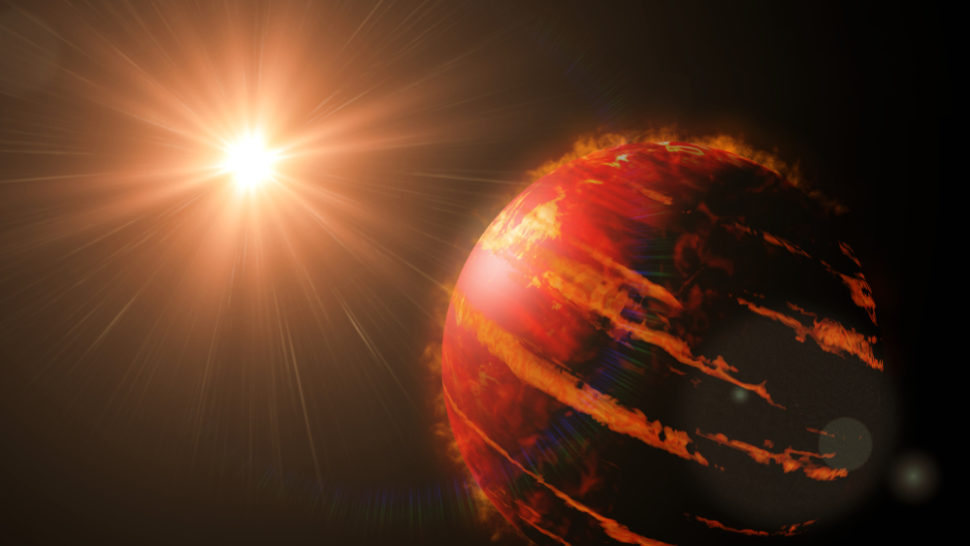Recently, scientists became ecstatic when a massive, super hot alien planet that has its own stratosphere was spotted by one of NASA’s space telescopes.
For decades, thousands of planets beyond our solar system were been discovered by NASA’s powerful telescopes such as the Hubble Space Telescope. However, this is the first time that scientists were able to find an exoplanet which shows evident signs of having a stratosphere.

An exoplanet is a planet outside of the solar system that is usually found orbiting another star.
Earlier this year, it was reported that astronomers have detected around seven new Earth-sized planets, three of which are located in the ‘habitable zone,’ the area around a star where a planet might potentially have liquid water and could sustain alien life.
#NASA 's #HubbleSpaceTelescope spotted giant exoplanet with stratosphere!Click To TweetThese exoplanets are part of the TRAPPIST-1 planetary system which is 39 light-years away from Earth or approximately 235 trillion miles away. A spaceship traveling at the speed of light would take 39 years to get there. However, there are still no spacecraft ever built that can go that fast.

To date, there are around 3,400 ‘confirmed‘ exoplanets that have been discovered and another 2,000 ‘candidate‘ exoplanets requiring further observation. Some of these alien planets are found in small regions of our Milky Way galaxy.
So, what is particularly special about this newly-discovered exoplanet?
Found Exoplanet with Water Atmosphere
The stratosphere is the layer of the atmosphere where temperature may increase with higher altitudes. Finding an exoplanet that has this layer of atmosphere is a breakthrough which can help astronomers better understand exoplanets and their atmospheric condition.
In a statement made by Mark Marley, a study co-author based at NASA’s Ames Research Center in California’s Silicon Valley he said:
“This result is exciting because it shows that a common trait of most of the atmospheres in our solar system–a warm stratosphere–also can be found in exoplanet atmospheres. We can now compare processes in exoplanet atmospheres with the same processes that happen under different sets of conditions in our own solar system.”
Published in the journal Nature, the exoplanet, dubbed as WASP-121b, was said to have been spotted and studied using NASA’s Hubble Space Telescope. It was a type of exoplanet known as a ‘hot Jupiter.’
According to the paper, WASP-121b has a mass which is 1.2 times that of Jupiter, and its radius is about 1.9 times of Jupiter’s. While Jupiter revolves around the sun once every 12 years, WASP-121b’s orbital period to its star is just 1.3 days.
Reports said that the exoplanet is so close to the star that if it comes nearer, it will be ripped apart by the star’s gravity. With that distance, scientists estimate that the planet’s top atmosphere could heat up to 4,600 degrees Fahrenheit or 2,500 degrees Celsius–enough to melt metals.

In a statement to Space.com, Thomas Evans of the University of Exeter in England and the lead author of the research, said:
“The question [of] whether stratospheres do or do not form in hot Jupiters has been one of the major outstanding questions in exoplanet research since at least the early 2000s. Currently, our understanding of exoplanet atmospheres is pretty basic and limited. Every new piece of information that we are able to get represents a significant step forward.”
By galactic standards, WASP-121b is considered to be close to Earth even at a distance of about 900 light years away.
While other exoplanets like WASP-33b were also found to have possible signs of stratosphere, WASP-121b is the best to date because of the signature of hot water molecules that was observed by scientists for the first time.
Apparently, the presence of hot water molecules indicates that the exoplanet’s top atmosphere layer temperature increases with the distance from the planet’s surface. Further analysis suggests that the bottom layer of the atmosphere, known as the troposphere, decreases its temperature with altitude.
The Study of WASP-121b
Using Hubble Telescope’s spectroscopy capabilities, Evans and his team were able to observe and analyze how the different molecules in WASP-121b’s atmosphere react to specific wavelengths of light.
For instance, the water vapor present in the planet’s atmosphere behaves in predictable ways depending on the wavelengths of light and the temperature of the water.
Tiffany Kataria, a study co-author, based at NASA’s Jet Propulsion Laboratory, Pasadena, California, explained:
“The emission of light from water means the temperature is increasing with height. We’re excited to explore at what longitudes this behavior persists with upcoming Hubble observations.”
Right now, scientists are still trying to determine what chemicals are causing the temperature increase in WASP-121b’s atmosphere. Possible candidates include Vanadium oxide and titanium oxide since they are commonly found in brown dwarfs or failed stars that share some common traits with exoplanets.
Evans firmly believed that next-generation observatories such as the NASA’s James Webb Space Telescope, that will be launched next year, and big ground-based observatories such as the Giant Magellan Telescope (GMT), the European Extremely Large Telescope (E-ELT) and the Thirty Meter Telescope (TMT), that are all expected to come online in 2020, will help scientists further explore Earth-like planets.



















Comments (0)
Most Recent